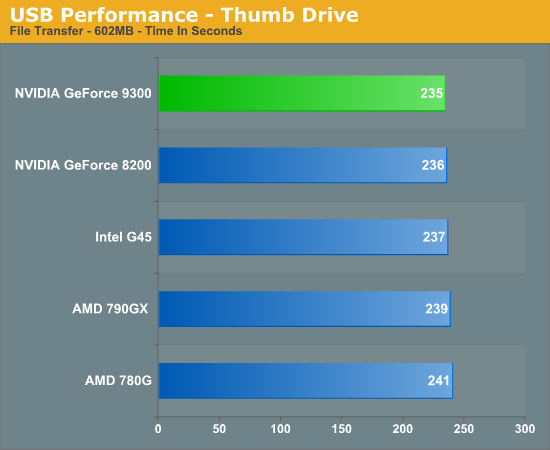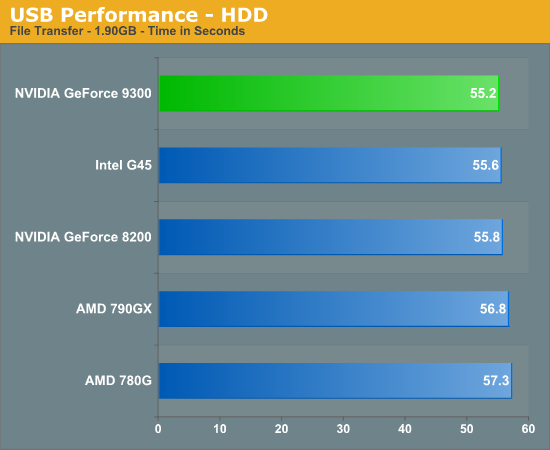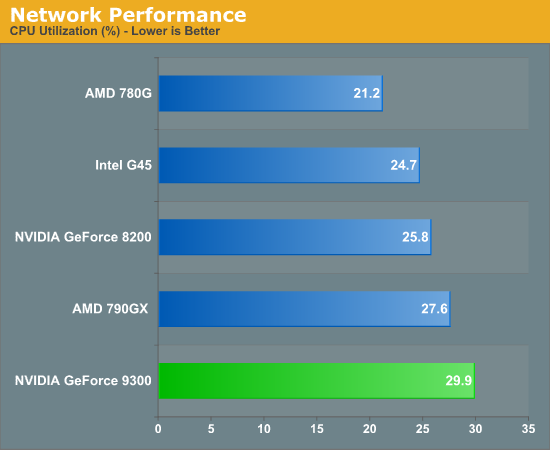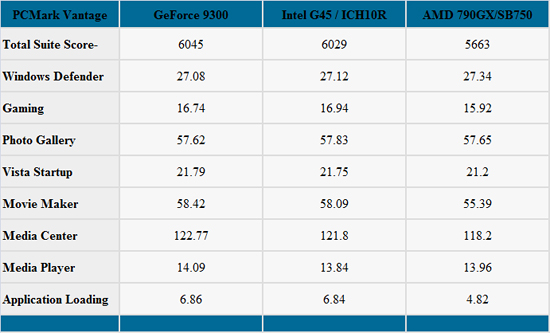The IGP Chronicles Part 3: NVIDIA's GeForce 9300
by Anand Lal Shimpi & Gary Key on October 15, 2008 12:00 AM EST- Posted in
- Motherboards
USB, Networking and Storage Performance
Our USB transfer speed tests were conducted with an OCZ Rally 2 Turbo 4GB Flash Drive and USB 2.0/FireWire based Maxtor OneTouch II external hard drive. In our first test, we transfer a 602MB file folder containing 444 files of various sizes. In our second test, we transfer a 1.90GB file folder containing 17 different files.
USB Performance


NVIDIA chipsets have always performed well in our USB tests and once again hold a slight edge over the Intel and AMD offerings. The improved USB performance from the AMD SB700/750 Southbridges almost close the gap with the NVIDIA and Intel offerings.
Ethernet Performance
The current motherboard test suite includes LAN performance measurements. All of these boards utilize PCI or PCI Express based Gigabit controllers with the only difference being the supplier of the core logic. The Windows 2000 Driver Development Kit (DDK) includes a useful LAN testing utility called NTttcp. We used the NTttcp tool to test Ethernet throughput and the CPU utilization of the various Ethernet Controllers used on the Intel motherboards.
We set up one machine as the server; in this test, an Intel system with an Intel CSA Gigabit LAN connection. Intel CSA has a reputation for providing fast throughput and is a logical choice for our Gigabit LAN server.
On the server side, we used the following Command Line as suggested by the VIA whitepaper on LAN testing:
Ntttcpr -m 4,0,‹server IP› -a 4 -l 256000 -n 30000
On the client side (the motherboard under test), we used the following Command Line:
Ntttcps -m 4,0,‹client IP› -a 4 -l 256000 -n 30000
At the conclusion of the test, we captured the throughput and CPU utilization figures from the client screen.


Our network throughput test indicates how well a particular controller design from Realtek, Marvell, NVIDIA, or Intel performs instead of being indicative of true chipset performance. This also holds true for the CPU utilization results, though this test can also be influenced to certain degree by the BIOS code and chipset interconnect design.
PCMark Vantage
PCMark Vantage is the latest benchmark available from Futuremark, and it is only for use with Windows Vista. Similar to the venerable PCMark05 in its makeup, Vantage modernizes the criteria and test methodology to reflect what users may encounter when running the new Windows OS and current applications. The total benchmark is roughly 87% reads and 13% writes in nature. We run each test five times per drive, producing a median score that we use for comparison in our charts. We utilize AHCI settings for each board.

NVIDIA chipsets generally provide excellent performance, albeit at the cost of stability at times, and our tests reveal a controller that is slightly better in performance than the Intel ICH10R. Really, it is a toss-up between the two controllers. The AMD SB750 trails slightly due to an AHCI implementation that is not as robust as the current NVIDIA or Intel offerings. However, it would be very difficult to discern any performance differences between these controllers in actual application work.
As we noted earlier, we had a few issues with AHCI settings and our Sony BDU-X10S BD drive along with some random slowdowns when transferring large amounts of data (Update- Latest BIOS/Firmware/Drives solved this problem). We have not and do not expect to notice any data corruption problems that crept up during the 780i/790i launch, which were eventually fixed by NVIDIA. Our Intel G45 board also had difficulties with the same Sony BD drive but the AMD SB700/750 have not been affected.










47 Comments
View All Comments
cghebert - Wednesday, October 15, 2008 - link
Hey guys,Great to see the articles are up. A couple of quick questions and a comment.
Could you mention clearly what nvidia driver versions (both graphics and HDMI) you used for the tests?
Also, you seem to hint that 5.1 audio is an option with this newest driver set from nvidia. Is this indeed the case?
Also, to echo the comments of some others, it would be nice to see the blu ray playback numbers with cheaper cpus. I have seen the Athlon X2 BE (2.3 ghz) going for less than $40, and even a 3 ghz X2 for $75 or so, which would certainly make buying a cheap discrete graphics card a viable option cost-wise.
nvmarino - Wednesday, October 15, 2008 - link
>>Unfortunately, as we've mentioned before, there is no support for bitstreaming Dolby TrueHD or DTS-HD MA; you'll need to wait until sometime next year before you get full support there.Hmm - does that mean the hardware is there in THIS chipset but we nned to wait for driver/bios updates!?!?!?!? Or are we talking about a new chipset?
Anand Lal Shimpi - Wednesday, October 15, 2008 - link
Sorry for the confusion, absolutely none of the current chipsets (G45, 780G, GF8200, GF9300) support or will support bitstreaming TrueHD/DTS-HD MA. Next year we will see the first GPUs with actual support for this.8-channel LPCM is the best you'll get for now.
-A
3DoubleD - Friday, October 17, 2008 - link
Isn't LPCM the best you can get anyway? Your Blu-ray decoder (Eg. PowerDVD, standalone Blu-ray player) decodes the audio stream (the best available) and sends that audio to your stereo via PCM. Some Blu-rays even have the LPCM stream raw on the disc. Why would you ever want/care about TrueHD/DTS-HD MA streaming when you are already getting perfect, lossless 7.1 audio to your speakers?Source: http://www.highdefdigest.com/news/show/1064">http://www.highdefdigest.com/news/show/1064
nvmarino - Wednesday, October 15, 2008 - link
Hybrd power was one of the more compelling features of this chipset for HTPC use - I want my box sipping as little juice as possible untile game time. Unfortunately, all the reviews I've read so far and this Nvidia page:http://www.nvidia.com/object/hybrid_sli_desktop.ht...">http://www.nvidia.com/object/hybrid_sli_desktop.ht...
seem to indicate Hybrid Power is NOT a feature of the new chipset. I read the comment earlier about it being up to board manufacturers to implement but the page linked above seems to indicate the chipset itself lacks support. Can you guys please confirm?
sascham - Wednesday, October 15, 2008 - link
I've been holding off buying my new rig for 3 months just for this feature. I'm on 100% solar power and although I can still run my current rig that draws more power than a newer one will, any savings I can make are worthwhile (and give me more scope elsewhere).All the reading I did months ago suggested this chipset would deliver Hybrid Power with Intel CPU. What's the official word on this? If, as the nvidia page linked suggests, this chipset does not deliver this, what's next? When do we get it?
Mr Roboto - Wednesday, October 15, 2008 - link
I'm not the brightest crayon on the box when it comes to tech but couldn't a company just solder on a decent chip and forget this whole IGP nonsense? Like take an Nvidia 9500 or 9600 chip and solder it right on to the board along with 128MB DDR RAM. You'd have you're reasonable gaming performance without suffering through the 9300 which looks to be nothing extraordinary. Couldn't they cool it with standard HSF?Seems to be a lot of effort for little reward.
sprockkets - Wednesday, October 15, 2008 - link
There would be little room for it, unless you gave up say two slots. Chaintech did this years ago, cool motherboard, but ran very hot. Suffice to say, no one bothers with it anymore. You might as well just add the memory like side port but a seperate chipset and graphics chip? Only works well in laptops.Calin - Thursday, October 16, 2008 - link
You're not saving so much money over a discrete video card (you still need everything a video card have), and you can't "upgrade" (yes, you can add another video card and disable the onboard one, but you can't have your cake and eat it too).3DoubleD - Wednesday, October 15, 2008 - link
Sounds great. Now all we need is a follow-up of the HD 4xxx article as well as confirmation about whether or not these Nvidia issues are solved or will be solved shortly.I'm really enjoying these HTPC based articles and hope you continue them. Now that the HDMI + 7.1 audio issue has finally been addressed I think it would be helpful to start looking into the software end of HTPCs, such as a Media Center software review (what programs that work well, include blu-ray playback, OTA support, network features, ect).
There are tempting systems such as the FuzeBox Media Server http://www.velocitymicro.com/wizard.php?iid=167">http://www.velocitymicro.com/wizard.php?iid=167 , which includes a seamless interface for Cablecard capture, blu-ray playback, multizone playback, expandable storage, network backups). The interface locks the user from exiting the media center interface, but provides a reliable, seamless, and feature rich experience that I have yet to experience with other media centers. The enthusiast looks at the price tag for such a machine and says, I can build that for half, except that the media center software isn't there. Help us enthusiast achieve that seamless experience without having to empty our pockets for pre-assembled box!
Thanks